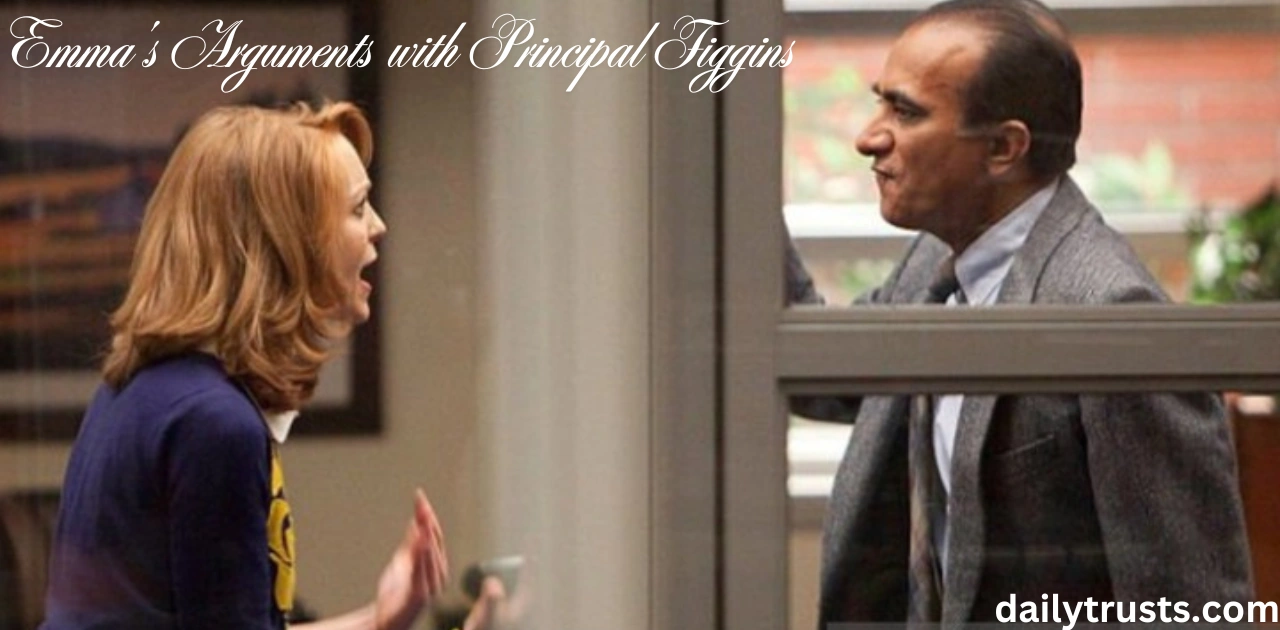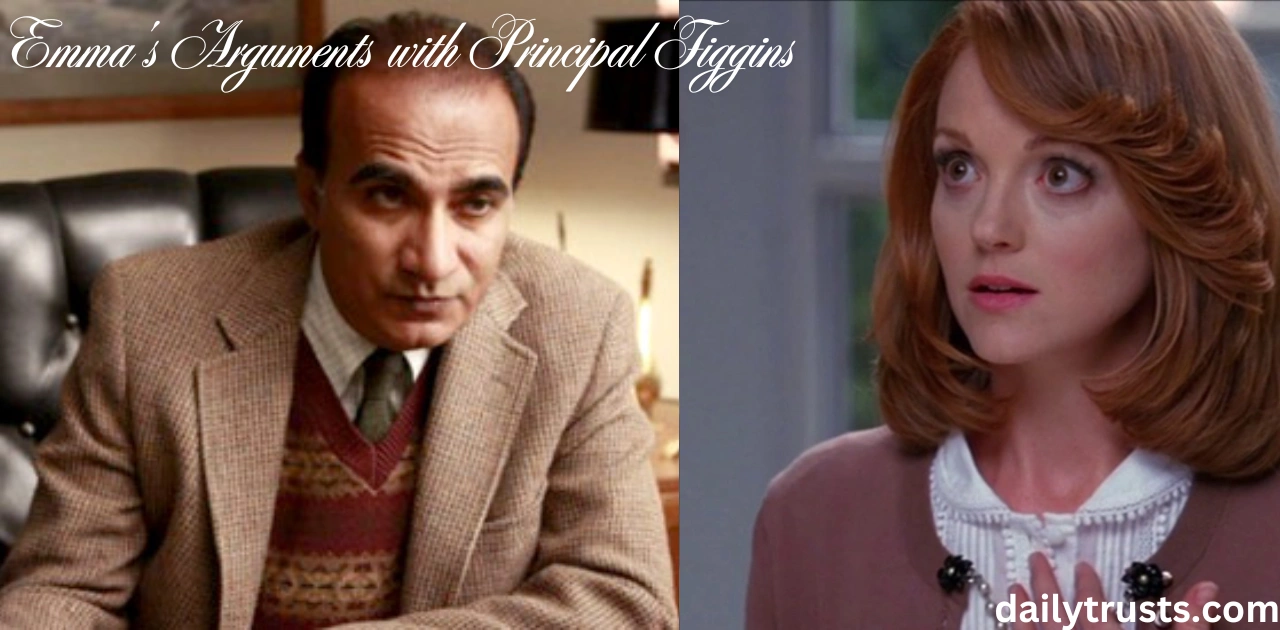Decoding the Debate: What Emma’s Arguments with Principal Figgins Reveal About Schools
In the world of Glee, few moments are as memorable as the heated exchanges between Emma Pillsbury and Principal Figgins. Emma and Principal Figgins engage in heated educational debates over school policies and student welfare. These arguments, particularly in Glee Season 1 Episode 7, titled “Throwdown,” are more than just dramatic television—they reflect real-world challenges in education. From budget constraints to differing philosophies on student well-being, Emma and Figgins’ clashes offer a window into the complexities of running a school. This article delves into the heart of their conflicts, exploring what they reveal about the educational system and how these lessons can be applied in real life.
The Heart of the Conflict: Exploring the Key Issues Between Emma and Figgins
Emma Pillsbury, the school’s guidance counselor, and Principal Figgins often find themselves at odds. Their disagreements stem from fundamental differences in their approaches to education, student welfare, and school administration. Let’s break down the key issues that fuel their arguments.
More Than Just Budget Cuts: Unpacking the Financial Strain in Glee and Real Schools
One of the central points of contention between Emma and Figgins is the school’s budget. In Glee Season 1 Episode 7, Emma advocates for more resources for the glee club, while Figgins is focused on cutting costs. This scenario mirrors real-life challenges where schools must balance limited budgets with the need to support extracurricular activities.
- Budget Constraints in Real Schools: According to a 2023 report by the National Center for Education Statistics, over 60% of public schools in the U.S. face budget cuts, impacting programs like arts and sports.
- Emma’s Advocacy: Emma’s push for the glee club highlights the importance of extracurricular activities in student development. Research shows that students involved in arts programs have higher academic performance and better social skills.
Discipline and Understanding: Contrasting Approaches of Emma and Figgins
Another major point of conflict is their differing views on discipline. Figgins often takes a more authoritarian approach, while Emma emphasizes understanding and empathy.
- Figgins’ Authoritarian Style: Figgins’ focus on rules and order reflects a traditional approach to school administration. While this can maintain discipline, it may also stifle creativity and student expression.
- Emma’s Empathetic Approach: Emma’s emphasis on understanding students’ emotional needs aligns with modern educational philosophies that prioritize mental health and emotional well-being.
Championing Student Well-being: Emma’s Advocacy Against Figgins’ Resistance
Emma’s arguments with Figgins often revolve around student well-being. She consistently advocates for policies that support students’ mental and emotional health, even when it means challenging Figgins’ decisions.
- Mental Health in Schools: Emma’s focus on student well-being is particularly relevant today, as schools increasingly recognize the importance of mental health support. According to the American Psychological Association, 1 in 5 students experiences a mental health disorder, yet only 20% receive the necessary support.
- Emma’s Role as a Counselor: Emma’s character highlights the critical role of school counselors in advocating for students’ needs, especially in the face of administrative resistance.
Beyond the Classroom: Real-World Lessons from Emma and Principal Figgins’ Disputes
The arguments between Emma and Figgins are not just entertaining television—they offer valuable lessons for educators, administrators, and even parents. Let’s explore how their conflicts can inform real-world practices.
Effective Communication in Education: What We Can Learn from Their Exchanges (and Missteps)
One of the key takeaways from Emma and Figgins’ arguments is the importance of effective communication. Their exchanges often highlight what not to do, but they also provide insights into how communication can be improved.
- Active Listening: Both Emma and Figgins could benefit from active listening. Instead of focusing on their own agendas, they should strive to understand each other’s perspectives.
- Collaborative Problem-Solving: Rather than approaching conflicts as battles to be won, educators and administrators should work together to find solutions that benefit everyone, especially the students.
Navigating Bureaucracy: Emma’s Struggles and Real-World Administrative Hurdles
Emma’s challenges in dealing with Figgins reflect the broader issue of navigating school bureaucracy. Her struggles to secure resources for the glee club are a microcosm of the difficulties educators face in advocating for their programs.
- Bureaucratic Barriers: In many schools, bureaucratic hurdles can prevent even the most well-intentioned initiatives from being implemented. Emma’s persistence serves as a reminder of the importance of advocacy and perseverance.
- Tips for Educators: To navigate bureaucracy effectively, educators should build alliances with colleagues, gather data to support their proposals, and communicate the benefits of their initiatives clearly and persuasively.
“Limited Context, Low Search Volume,” High Insight: Finding Value in a Specific Glee Storyline

While the specific storyline of “Emma argues with Principal Figgins” may have limited context and low search volume, it offers high insight into broader educational issues. By examining this specific conflict, we can gain a deeper understanding of the challenges faced by educators and administrators.
- Microcosm of Broader Issues: The arguments between Emma and Figgins serve as a microcosm of the larger debates in education, such as budget constraints, disciplinary approaches, and student well-being.
- Relevance to Real-World Education: These themes are not unique to Glee—they are relevant to schools everywhere, making this storyline a valuable case study for educators and administrators.
Emma Argues with Principal Figgins: A Clash of Ideals in School Leadership
Emma Pillsbury and Principal Figgins represent two contrasting leadership styles within the school system. While Figgins prioritizes administrative efficiency and budget management, Emma focuses on student well-being and emotional support. Their arguments highlight the ongoing struggle between bureaucracy and student-centered education. This clash of ideals reflects real-world educational debates, where school leaders must balance institutional policies with the individual needs of students. By analyzing their disagreements, we gain insights into the challenges educators face in fostering a supportive yet structured learning environment.
Emma Argues with Principal Figgins: Power Struggles in School Administration
Emma Pillsbury and Principal Figgins often find themselves in a battle of authority, representing the tension between administrative control and student advocacy. Figgins, as the school’s principal, enforces strict policies to maintain order and manage resources, while Emma, as a guidance counselor, challenges decisions that she believes harm student well-being. Their disagreements shed light on the struggles within school administration, where rigid bureaucratic rules sometimes clash with the need for a more compassionate, student-first approach. This dynamic reflects real-life challenges in educational leadership, where decision-making power can shape the overall learning environment.
FAQs: Emma and Principal Figgins’ Arguments
Q: What episode does Emma argue with Principal Figgins?
A: Emma’s arguments with Principal Figgins are prominently featured in Glee Season 1 Episode 7, titled “Throwdown.”
Q: What are the main issues Emma and Figgins argue about?
A: Their arguments typically revolve around budget constraints, disciplinary approaches, and student well-being.
Q: How does Emma’s character influence her arguments with Figgins?
A: Emma’s role as a guidance counselor and her empathetic nature drive her to advocate for students, often putting her at odds with Figgins’ more bureaucratic approach.
Q: Are Emma and Figgins’ arguments relevant to real-world education?
A: Yes, their conflicts reflect real-world challenges in education, such as budget cuts, disciplinary policies, and the importance of student mental health.
Conclusion: Emma and Figgins’ Educational Debates
The arguments between Emma Pillsbury and Principal Figgins in Glee are more than just dramatic television—they offer valuable insights into the challenges of running a school. Their conflicts reflect real-world issues that educators and administrators face daily. These issues range from budget constraints to differing approaches to discipline and student well-being. By examining these debates, we can learn important lessons about effective communication, navigating bureaucracy, and advocating for students’ needs.
As we reflect on these lessons, let’s consider how we can apply them in our own lives. Whether you’re an educator, administrator, or simply a fan of Glee, there’s much to learn from Emma and Figgins’ exchanges. Share your thoughts in the comments below and explore related topics. Continue the conversation about the challenges and opportunities in education today.
